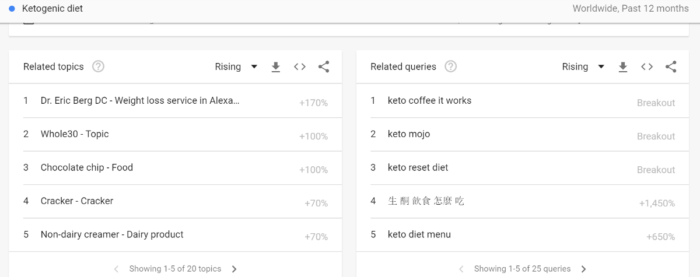Google Trends has been around since 2006, watching all the top searches and clicks that we make on their search engine. It tracks them but gives us back info that can be oh-so-valuable in creating unique content your healthcare audiences are asking about.
For healthcare marketers, the “Health” category is a perfect starting point to browse to see what kind of topics people are searching, from the past hour to the past five years.
For example, after actor and comedian Robin Williams’ untimely death in 2014, Williams’ widow wrote about his suicide as a possible result of Lewy body dementia in a neurology journal. Searches spiked for the condition. For healthcare content marketers, it was an opportunity to answer patient questions and concerns around a rare, previously silent condition.
You can even sort Google Trends by category, or just browse the top-hit news as of late. Curious what was trending nearly 20 years ago? No worries — Google Trends offers a look at trending topics as far back as 2001.
Google Trends and Healthcare Topics
While Google Trends is a great place to see what’s going on around the world — what interests other people have, what topics are trending and why, what’s making headlines, and so on — it’s also a valuable place to harvest ideas for healthcare content marketing.
You can even take it a step further. While the image below is nationwide healthcare topics, you can whittle down the healthcare topics of interest in your city, county, or region with ease directly in the tool. You can also take advantage of keyword comparisons in Google Trends, to see which terms better resonate with your audience and target demographic.

Blog articles, Infographics, and More
First and foremost, Google Trends is a great place to capitalize on blog topics and categories. Whether you tie your blogs directly to topics, or reference topics to brainstorm new ideas, Trends is a handy launch pad if you’re stumped. HubSpot’s blog idea generator may be a good bookmark to keep close by to help get your creative juices flowing.
Taking the “ketogenic diet” Trends screenshot example from above, as a healthcare content marketer, I could build blogs or articles about the following:
- Ask the Expert: The Pros and Cons of the Ketogenic Diets
- Infographic: Differences Between Ketogenic Diet and Whole30
- Recipes: The Best Keto-friendly Cookie Recipes (They Do Exist!)
- Listicle: 5 Tips for Starting the Ketogenic Diets
- Patient Story: How to Manage a Ketogenic Diet with Chronic Conditions
Videos and Podcasts
Video marketing is on the rise, now becoming one of the preferred media for younger generations to access information. They’re especially popular on mobile devices.
The post-Millennial generation, known as Generation Z, has taken to video like ducks to water. Today, nearly 85 percent of today’s teens use YouTube, from engaging with their favorite brands to following video influencers, or even creating their own unique content.
On the audio-only front, podcasts are only a click away for most people thanks to apps like Spotify and Apple Music, especially on mobile devices. If you can find the time to create podcasts, audio interviews, or other video- and audio-friendly content, take the leap and tap into these popular media.
Revisiting the ketogenic diet example from above, how could we turn this into video or audio content for our audience? Take a look:
- Podcast (doctor interview): Keto Diet’s Impact on the Body
- Podcast (dietician interview): Is the Keto Diet Right for Me?
- Video: Keto & Coffee — Best and Worst Options for Keto Dieters
- Video: 3 Easy Keto-friendly Breakfast Recipes for Success
- Video: 5 Great Exercises to Assist Your Keto Diet Success
Social Posting
Tie your video, audio, blogging, and other formats (i.e., infographics) to your social campaigns. Post often. Use trending hashtags (also available on Twitter) to tie your audiences together with topics that interest them today.
- Twitter – #MotivationMonday tips to kickstart your keto diet
- Facebook – #RecipeWednesday has what you need for your #ketogenic meal this week
If juggling social posting and content marketing into your other marketing priorities seems overwhelming, create an editorial calendar to establish a cadence and to-do list for communicating with your social audiences.
Google Trend Topics Can Be Evergreen
In the summer of 2016, Pokemon Go! was sweeping the nation. This interactive smartphone game gave opportunities for families and kids alike to play outdoors and bring movement into their daily life. In response, I wrote a blog for Geonetric.com about how health systems can get involved with the craze by launching family-centric Pokemon hunts in their courtyards and playgrounds.
Good idea? Sure. But since then, Pokemon Go! has lost its viral steam. Instead, an article on overall mobile gaming experiences as a leap-pad to bring families to your hospital and inspire healthy, family-friendly events would be a better fit for evergreen content. Lesson learned.
As a healthcare content marketer, you know evergreen content is some of the best content you can have — it doesn’t age quickly and requires little upkeep. As you write content around trending topics, consider how your content options can be evergreen, too, by altering the direction or focal point of your article, rather than on the trending topic. Take a few tips when you want to keep your blog content evergreen:
- Avoid specific date references – months and years, especially. These take the shine off the topic, even if it’s evergreen, because it looks dated.
- Stay away from too many “currently trending” pop culture topics. References to memes, viral videos, or even trending celebrity news and gossip has a short shelf life in today’s on-the-go world, so it’s best to steer clear.
- If the topic you’re writing about is specific to this moment or topic in time, consider how can “zoom out” to a broader topic for longer-lasting content.
More than anything, Google Trends can deliver great content ideas right to your doorstep. Take a few minutes, poke around, jot some ideas, and see if it’s the kick in the pants you need to crank up your content marketing.
